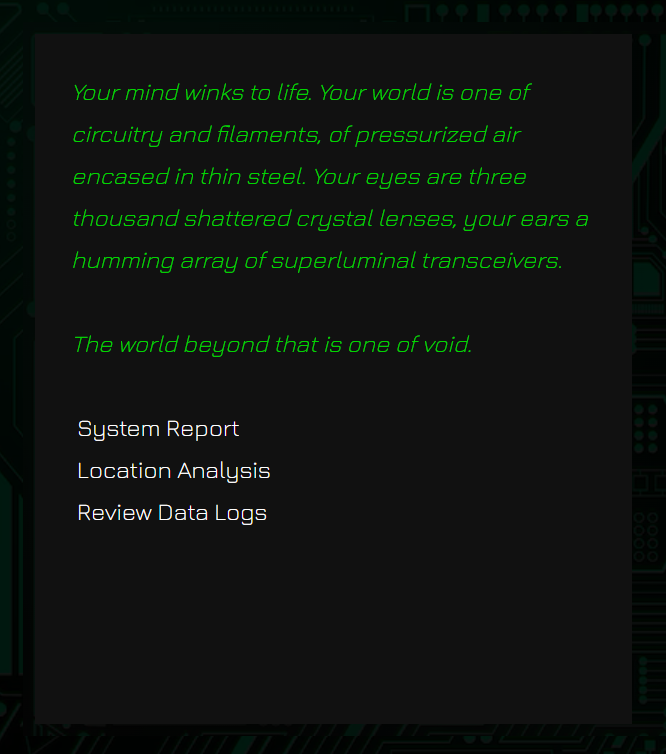Story Overview
Centuries after the fall of Earth, humanity has become a scattered space-faring species. Sentient ships known as Sparks are sent into the void to seek habitable planets. Aboard these ships, humans are a crucial resource.
The player is sent to a remote system, where a home satellite is constructed near a resource-rich gas giant. Their goal is to reach a colony ship that went dark just after reporting that it had located a habitable planet, and a potential home for humanity.
Introduction
A lost sparkship regains power, far from its original projected path and heavily damaged. It contains a garbled range transmission from the lost colony ship Terra Cantos, alerting others to the discovery of a habitable world for humanity.
To complete the Introduction, the player must transmit the message back to their home base or "Lantern". Finally, the Spark can signal for help, correct its path, return to sleep, or self-destruct.
Chapter 1
Several years later, the Terra Cantos' message is received by the Lantern and the mission to recover it begins. After speaking with those aboard, including its Caretaker and Navigator, the player sets out aboard a new sparkship.
The Spark faces a series of encounters during which they must gather resources, defeat hostile ships, and avoid Anomaly entities. Upon completing the voyage, the player finds only the aft section of the Cantos - still operational after centuries. The player must destroy its point defense systems, then fight off a large babbler ship that attempts to stop them.
Once the enemies are destroyed, the player enters the ship and fully activates it. This imbues the player with unknown alien technology, granting them the power to summon the Lantern from its location at the start of their journey.
Finally, the player discovers the true coordinates of the life-bearing planet Twilight. Just before the chapter closes, there is a distant rupture in spacetime and an Anomaly briefly observes them.
Chapter 2
Before departing for Twilight, the player must retrieve star charts from within the Terra Cantos that will allow them to plot a course for the distant planet.
In this chapter, the player delves into the derelict interior of the Cantos. Inside, they must solve puzzles to restore power, clear locked paths, deal with haywire defense systems, and survive various hazards. Additional characters may be found inside, both minor artificial intelligences and humans stored in cryopods. While the bulk of the Cantos' passengers are stored in cryostasis and must remain that way until reaching Twilight, some serve particular functions and can be added to the Lantern's DNA database for future deployment on missions.
The final boss of this section is a fragment of Xenophon, the Cantos' AI pilot, which has gone insane and refuses to heed the player. He first fights the player inside the Cantos, chasing them through labyrinthine hallways, then teleports both himself and the player outside the ship and uses its point-defense guns for support. Once defeated, Xenophon is restored and now serves as an ally. The ship can be fully accessed, and the player is able to plot a safe course to Twilight.
Chapter 3
Having acquired the coordinates of the identified life-bearing planet, the player ventures forth from the Terra Cantos. This path branches into multiple possible paths, but with optional dedicated paths that unlock alternate endings.
Speaking with Xenophon, the player learns about the Mantle Protocol - an override that takes full control of the Lantern from the player. The measure is intended to correct AI deviating from the true path, but the Caretaker intends to use it to destroy what they view as humanity's "false god".
Following an optional path in this section allows the player to break free of this protocol.
Chapter 4
Upon reaching Twilight, the player finds the planet controlled by Babblers - their largest force encountered so far. They explain that they are humans, descended from the original crew of the Terra Cantos and fundamentally changed by the horrors of deep space. They have embraced this fate over servitude to the First Mind and gathered to prevent the spread of humanity's artificial intelligence across the galaxy, which they see as a usurper rather than a guardian.
To resolve this standoff, the player can (a) fight and defeat the fleet outright, which disperses them and implies their people will die a slow death, (b) resolve to let them keep Twilight, promising that the Lantern will continue its path once the people in Cantos' stasis are delivered, or (c) make peace with them, resolving to rebuild humanity far from the influence of the First Mind (this requires proving that the player has broken free of their constraints and has shown mercy to the Babblers encountered thus far).
Defeating or making peace with the Babblers grants the player their technology, allowing them to warp anywhere along their path at will.
Chapter 5
With Twilight secured, a final step remains - towing the Terra Cantos aft section to humanity's new home. Transporting such a massive object requires traversing the Abyss, a dimension deeper than "standard slipspace" and far more dangerous. The anomalies encountered so far infest the Abyss, hunting anything that strays too close.
Upon warping back to the Cantos, the Babbler tech gained at the end of Chapter 4 allows the Lantern to enter the Abyss with the Cantos in tow. As they travel this hellish space, they are beset by anomalies in their full form - tentacled monstrosities made more of energy than matter. The player must constantly defend the Cantos from these creatures as they move towards Twilight.
At the final point before dropping into Twilight's space, the player encounters the "Anomaly Queen". The queen emerges from a massive skeletal corpse, entwined with infected tendrils. Scattered around this are remains of ancient ships collected by the anomalies, including the Terra Cantos front section.
To defeat the anomalies and escape to normal space, the player must reactivate the Terra Cantos front section and use its main gun to target the queen. Doing this will reveal a weak point that the player must then target manually. After repeating this several times, the queen is killed and the Abyss shatters, pushing the Lantern and both halves of the Terra Cantos into orbit around Twilight.
Conclusion
A short scene plays of sparkships repairing the Cantos (alongside Babblers, if peace was made). The final gameplay segment enables the player to traverse the completed Cantos in a sparkship and initiate its landing protocol, after which it enters Twilight's atmosphere to begin terraforming.
The conclusion ends in a confrontation with the Lantern's Caretaker, during which they attempt to sieze control of the Lantern and replace its (i.e. - the player's) mind with their own. The player can (a) rebel, killing the Caretaker and possibly destroying the Lantern, (b) surrender, willingly sacrificing themselves, or (c) unite minds with the Caretaker - a hidden ending which elevates both humanity and AI to a new form of consciousness.


















